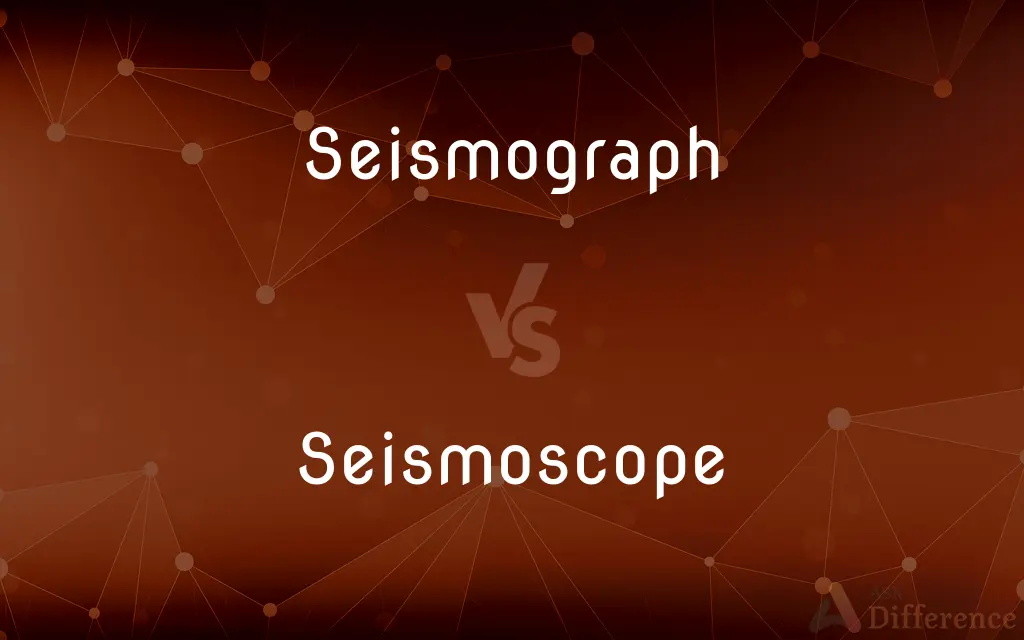Seismograph vs. Seismoscope — What's the Difference?
By Maham Liaqat & Fiza Rafique — Updated on May 6, 2024
A "seismograph" is an instrument that measures and records the magnitude and duration of seismic waves, while a "seismoscope" is an older device designed to indicate the occurrence of an earthquake without providing detailed measurements.

Difference Between Seismograph and Seismoscope
Table of Contents
ADVERTISEMENT
Key Differences
A seismograph actively records earthquake activity, providing detailed data about the intensity, direction, and duration of seismic waves. On the other hand, a seismoscope merely indicates that an earthquake has occurred, usually by moving an object or triggering a visual marker.
Seismographs are essential tools for seismologists as they generate graphs that help pinpoint earthquake epicenters and estimate magnitudes. Seismoscopes, however, serve a simpler purpose, primarily providing a visual indication of earthquake occurrence without scientific measurement.
Modern seismographs include electronic sensors and computer software that analyze seismic data in real time, while seismoscopes are largely historical and were often mechanical devices that functioned without electricity.
While both instruments aim to detect earthquakes, seismographs offer precision and detailed records, whereas seismoscopes are limited to basic detection and are not used in modern seismology.
Comparison Chart
Purpose
Record earthquake data
Indicate an earthquake occurred
ADVERTISEMENT
Data Type
Detailed measurements (graphs)
Binary indicator (yes/no)
Technology
Modern electronics and sensors
Historical, mechanical
Usefulness
Crucial for modern earthquake research
Mainly historical interest
Accuracy
High, with precise readings
Low, only indicates earthquake presence
Compare with Definitions
Seismograph
Instrument measuring seismic waves.
The seismograph recorded the aftershocks clearly.
Seismoscope
Tool identifying seismic activity without measuring.
A seismoscope simply tilts to signal ground movement.
Seismograph
Machine for detecting tremors.
A network of seismographs tracks global earthquake patterns.
Seismoscope
Old mechanism for quake detection.
In historical times, a seismoscope was the primary earthquake warning device.
Seismograph
Tool measuring the quake’s magnitude.
Seismographs helped classify the earthquake as magnitude 7.0.
Seismoscope
Device indicating an earthquake occurred.
The ancient seismoscope revealed earthquake events.
Seismograph
Equipment for seismic research.
The field team set up portable seismographs near the fault.
Seismoscope
Tool showing quake presence.
After shaking, the seismoscope indicated a quake.
Seismograph
Device providing graphs of seismic activity.
Scientists analyzed seismograph data to understand the earthquake's impact.
Seismoscope
Instrument detecting quakes visually.
A seismoscope shifts weights to show quake direction.
Seismograph
An instrument for automatically detecting and recording the intensity, direction, and duration of a movement of the ground, especially of an earthquake.
Seismoscope
An instrument that indicates the occurrence or time of occurrence of an earthquake.
Seismograph
An instrument that automatically detects and records the intensity, direction and duration of earthquakes and similar events.
Seismoscope
An instrument that indicates the occurrence of an earthquake.
Seismograph
An apparatus for registering the shocks and undulatory motions of earthquakes.
Seismoscope
A seismometer.
Seismograph
A measuring instrument for detecting and measuring the intensity and direction and duration of movements of the ground (as an earthquake)
Common Curiosities
Can seismographs be used to predict earthquakes?
Not directly; seismographs help understand seismic patterns but cannot predict specific earthquakes.
Are seismoscopes still in use today?
Seismoscopes are mainly of historical interest, as modern seismographs provide more precise data.
Who invented the first seismoscope?
The first known seismoscope was invented by Zhang Heng in ancient China.
What does a seismograph measure?
A seismograph measures the magnitude, duration, and direction of seismic waves during earthquakes.
Does a seismoscope provide detailed measurements?
No, a seismoscope only indicates the occurrence of an earthquake, not its intensity or duration.
How does a seismoscope work?
A seismoscope usually functions through a mechanical system that moves a marker or object during tremors.
Are seismographs portable?
Some seismographs are portable and can be used in field research.
How is a seismograph calibrated?
Seismographs are calibrated using known seismic data and regular maintenance.
What data does a seismograph produce?
A seismograph produces seismograms, which are graphs depicting seismic wave activity over time.
Can seismographs identify earthquake epicenters?
Yes, by analyzing seismic wave arrival times, seismographs help pinpoint earthquake epicenters.
What technology powers modern seismographs?
Modern seismographs rely on electronic sensors and computer systems to detect and analyze seismic data.
What is the oldest known seismoscope?
Zhang Heng’s seismoscope from ancient China is considered the oldest known device.
Can seismographs detect volcanic activity?
Yes, seismographs can detect volcanic tremors associated with eruptions.
How sensitive is a seismograph?
Seismographs can detect seismic waves from both local and distant earthquakes, even those not felt.
Can a seismoscope be automated?
Historical seismoscopes were often mechanical, not automated like modern seismographs.
Share Your Discovery

Previous Comparison
Devoted vs. Devout
Next Comparison
Man vs. HumanAuthor Spotlight
Written by
Maham LiaqatCo-written by
Fiza RafiqueFiza Rafique is a skilled content writer at AskDifference.com, where she meticulously refines and enhances written pieces. Drawing from her vast editorial expertise, Fiza ensures clarity, accuracy, and precision in every article. Passionate about language, she continually seeks to elevate the quality of content for readers worldwide.
















































